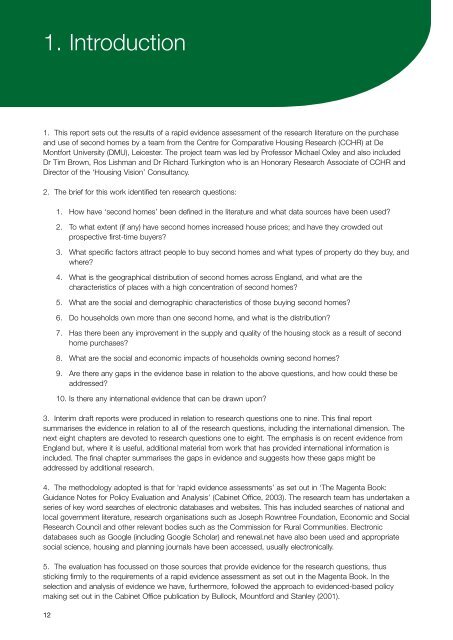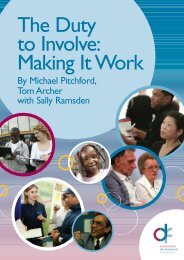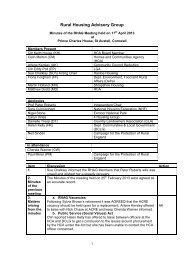Rapid Evidence Assessment of the Research ... - Rural Housing
Rapid Evidence Assessment of the Research ... - Rural Housing
Rapid Evidence Assessment of the Research ... - Rural Housing
Create successful ePaper yourself
Turn your PDF publications into a flip-book with our unique Google optimized e-Paper software.
1. Introduction<br />
1. This report sets out <strong>the</strong> results <strong>of</strong> a rapid evidence assessment <strong>of</strong> <strong>the</strong> research literature on <strong>the</strong> purchase<br />
and use <strong>of</strong> second homes by a team from <strong>the</strong> Centre for Comparative <strong>Housing</strong> <strong>Research</strong> (CCHR) at De<br />
Montfort University (DMU), Leicester. The project team was led by Pr<strong>of</strong>essor Michael Oxley and also included<br />
Dr Tim Brown, Ros Lishman and Dr Richard Turkington who is an Honorary <strong>Research</strong> Associate <strong>of</strong> CCHR and<br />
Director <strong>of</strong> <strong>the</strong> ‘<strong>Housing</strong> Vision’ Consultancy.<br />
2.<br />
12<br />
The brief for this work identified ten research questions:<br />
1. How have ‘second homes’ been defined in <strong>the</strong> literature and what data sources have been used?<br />
2. To what extent (if any) have second homes increased house prices; and have <strong>the</strong>y crowded out<br />
prospective first-time buyers?<br />
3. What specific factors attract people to buy second homes and what types <strong>of</strong> property do <strong>the</strong>y buy, and<br />
where?<br />
4. What is <strong>the</strong> geographical distribution <strong>of</strong> second homes across England, and what are <strong>the</strong><br />
characteristics <strong>of</strong> places with a high concentration <strong>of</strong> second homes?<br />
5. What are <strong>the</strong> social and demographic characteristics <strong>of</strong> those buying second homes?<br />
6. Do households own more than one second home, and what is <strong>the</strong> distribution?<br />
7. Has <strong>the</strong>re been any improvement in <strong>the</strong> supply and quality <strong>of</strong> <strong>the</strong> housing stock as a result <strong>of</strong> second<br />
home purchases?<br />
8. What are <strong>the</strong> social and economic impacts <strong>of</strong> households owning second homes?<br />
9. Are <strong>the</strong>re any gaps in <strong>the</strong> evidence base in relation to <strong>the</strong> above questions, and how could <strong>the</strong>se be<br />
addressed?<br />
10. Is <strong>the</strong>re any international evidence that can be drawn upon?<br />
3. Interim draft reports were produced in relation to research questions one to nine. This final report<br />
summarises <strong>the</strong> evidence in relation to all <strong>of</strong> <strong>the</strong> research questions, including <strong>the</strong> international dimension. The<br />
next eight chapters are devoted to research questions one to eight. The emphasis is on recent evidence from<br />
England but, where it is useful, additional material from work that has provided international information is<br />
included. The final chapter summarises <strong>the</strong> gaps in evidence and suggests how <strong>the</strong>se gaps might be<br />
addressed by additional research.<br />
4. The methodology adopted is that for ‘rapid evidence assessments’ as set out in ‘The Magenta Book:<br />
Guidance Notes for Policy Evaluation and Analysis’ (Cabinet Office, 2003). The research team has undertaken a<br />
series <strong>of</strong> key word searches <strong>of</strong> electronic databases and websites. This has included searches <strong>of</strong> national and<br />
local government literature, research organisations such as Joseph Rowntree Foundation, Economic and Social<br />
<strong>Research</strong> Council and o<strong>the</strong>r relevant bodies such as <strong>the</strong> Commission for <strong>Rural</strong> Communities. Electronic<br />
databases such as Google (including Google Scholar) and renewal.net have also been used and appropriate<br />
social science, housing and planning journals have been accessed, usually electronically.<br />
5. The evaluation has focussed on those sources that provide evidence for <strong>the</strong> research questions, thus<br />
sticking firmly to <strong>the</strong> requirements <strong>of</strong> a rapid evidence assessment as set out in <strong>the</strong> Magenta Book. In <strong>the</strong><br />
selection and analysis <strong>of</strong> evidence we have, fur<strong>the</strong>rmore, followed <strong>the</strong> approach to evidenced-based policy<br />
making set out in <strong>the</strong> Cabinet Office publication by Bullock, Mountford and Stanley (2001).






